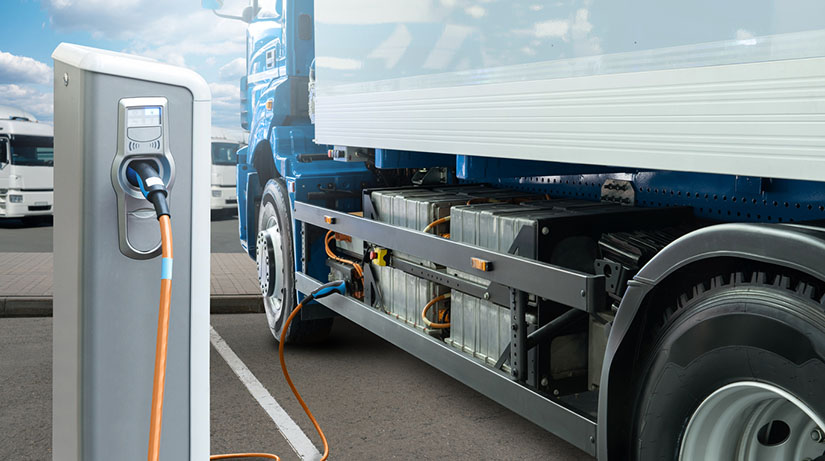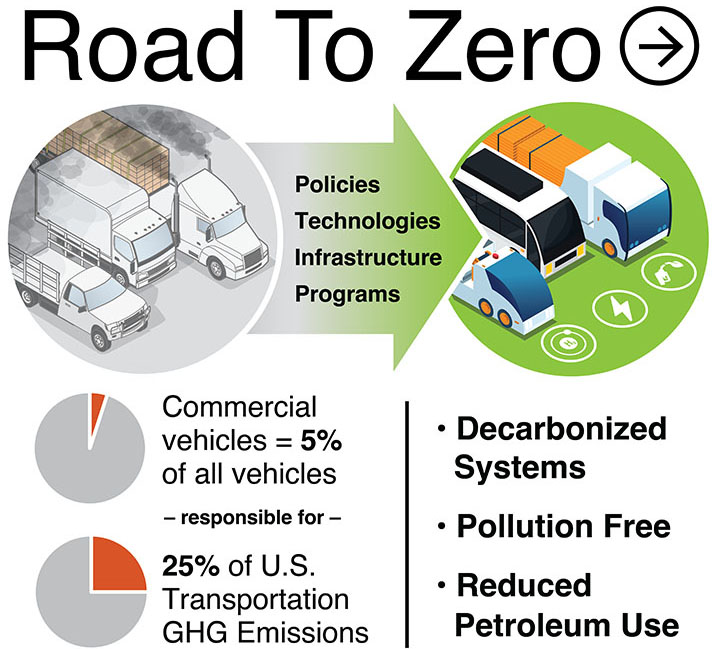NREL Collaborates With Volvo Group To Chart Course Toward Zero-Emission Commercial Vehicles

In collaboration with Volvo Group, National Renewable Energy Laboratory (NREL) researchers charted a path forward for achieving a zero-emission future for medium- and heavy-duty vehicles (MHDVs). Together, the industry/research team explored the current status and mapped the opportunity space and the requirements for various technologies that could help turn that vision into reality.

A recent peer-reviewed article in the journal iScience—"Road to Zero: Research and Industry Perspectives on Zero-Emission Commercial Vehicles"—details their findings.
Why is this transition important? MHDVs such as large pickup trucks, delivery vans, and larger trucks comprise just 5% of vehicles on the road in the United States, yet they account for nearly 30% of on-road fuel consumption and 25% of total transportation greenhouse gas (GHG) emissions.
Clean technology solutions are available today to spur the transition to a zero-emission commercial vehicle sector.
Because of the large variety of medium- and heavy-duty vehicle types and applications, several technologies present opportunities for decarbonization, including plug-in battery electric vehicles (BEVs) and hydrogen fuel cell electric vehicles (FCEVs) using clean hydrogen. Both BEVs and FCEVs are zero-emission vehicles (ZEVs), offering inroads to solving air quality issues associated with transportation. Sustainable liquid fuels offer additional opportunities to reduce emissions, especially for legacy internal combustion engine vehicles (ICEVs).
Battery Electric Vehicles
Currently the most mature technological solution for decarbonizing MHDVs, BEVs have benefitted from significant battery cost reductions—particularly in the light-duty market but anticipated in the commercial vehicle market—and technology improvements during the last decade. They offer multiple performance advantages, such as greatly reduced driving and maintenance costs, improved performance and safety, and better reliability. And thanks to offering a superior driving experience, these vehicles can also bolster driver retention.
Yet challenges remain in terms of driving range, recharging time, charging infrastructure availability, and higher purchase prices compared to ICEVs. However, studies suggest that BEVs could become cost competitive for multiple MHDV applications in the near term thanks to further reductions in battery costs plus low operating costs stemming in part from their high powertrain efficiencies.
"According to our projections—which leverage NREL's Transportation Energy & Mobility Pathway Options (TEMPOTM) model—BEVs could become cost-competitive for smaller trucks this decade and for most heavy trucks by 2035," said Matteo Muratori, NREL group manager and lead author of the report. "Meanwhile, FCEVs could become cost-competitive for long-haul heavy trucks in the 2030s."
"These are promising technologies," said Aravind Kailas, advanced technology policy director at Volvo Group and co-author of the article. "The timing of their deployment as well as their success in the marketplace will hinge on a variety of key factors such as technology advancements, operating conditions, ample infrastructure, and the production cost of clean hydrogen, for example."
Hydrogen Fuel Cell Electric Vehicles
FCEVs offer driving ranges and refueling times comparable to today's diesel trucks, but vehicle and clean hydrogen costs are not yet cost effective for the MHDV market. Still, FCEVs could offer a compelling alternative to complement BEVs, especially for hard-to-electrify applications with challenging duty cycles such as long-haul trucking.
"If fuel cell and hydrogen technologies progress in line with U.S. Department of Energy targets, a combination of BEVs and FCEVs could offer cost-competitive solutions for about 40% of MHDV sales in 2030 and a pathway to full ZEV market success in the 2040s," Muratori added.
Internal Combustion Engine Vehicles Using Sustainable Liquid Fuels
"Drop-in" sustainable fuels such as sustainable biofuels and e-fuels offer an additional alternative. Along with significant GHG emissions savings, they do not require major changes to existing vehicles or fuel dispensing equipment. However, limited feedstock supply and high costs slow the use of sustainable biofuels, while significant electricity requirements, uncertain technology timelines, and high production costs pose barriers to the large-scale use of e-fuels.
Nevertheless, such fuels could provide a solution for MHDV applications that prove particularly challenging to decarbonize via BEVs or FCEVs, as well as the opportunity to reduce emissions in legacy internal combustion engine vehicles during the transition to ZEVs.
Powering the Transition to Zero-Emission Commercial Vehicles
Collaboration is key. The iScience journal article serves as just one example of the type of collaboration needed to support the successful transition to ZEVs by ensuring that research and development activities are aligned with infrastructure build-out, deployment efforts, and industry needs and goals.
"We approached this study from a blended industry/research vantage point to ensure our research vision was grounded in the real-world experience and practical perspective of a well-established industry leader like Volvo Group," Muratori said.
"Decarbonizing MHDVs is a critical step to achieving the nation's climate and air quality goals and we are committed to being part of the solution," Kailas said. "A rapid transition to ZEVs requires many non-traditional stakeholders working together as well as access to incentives and grants for vehicles and charging infrastructure."
A full-scale transition to ZEVs will necessitate effective coordination between multiple stakeholders including state agencies, local governments, automotive manufacturers, fleets, energy infrastructure and utility companies, as well as research and academia. For instance, as charging and fueling networks expand, it is critical that system-level solutions ensure interoperability and effective integration with electricity systems, all supported by forward-looking planning.
Policy support mechanisms, such as rebates and incentives, can help jump-start ZEV adoption and infrastructure deployment by offsetting capital costs for early adopters. And landmark programs, launched as part of the Infrastructure Investment and Jobs Act and the Inflation Reduction Act, are spurring a never-before-seen level of ZEV activity in the United States.
Learn more about NREL's sustainable transportation and mobility research and cross-sector decarbonization efforts. And sign up for NREL's quarterly transportation and mobility research newsletter, Sustainable Mobility Matters, to get the latest news.
Last Updated May 28, 2025
